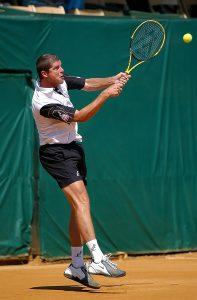We may earn money or products from the companies mentioned in this post.
Brief Definition of Western Grip in Tennis

In the world of tennis, there are various grips that players can use to hold their racket One such grip is the Western grip, which is characterized by placing the base knuckle of the index finger on the third bevel of the racket handle This grip gets its name from the fact that it was popularized by many top players from Western countries
Importance of Understanding Grips in the Game

Understanding and mastering different grips in tennis is crucial for any player who wants to excel on the court Grips play a significant role in determining how effectively you can control your shots, generate power, and add spin to your strokes Each grip has its own unique advantages and disadvantages, and having a solid understanding of them allows you to adapt your game according to different situations and opponents
Enhanced Shot Selection
Knowing how to use the Western grip opens up a whole new range of shot options for players This grip enables them to hit powerful topspin shots with ease, allowing for greater control over ball trajectory and bounce With topspin, players can generate more spin while keeping their shots within bounds, making it harder for opponents to return or attack effectively
Better Defensive Capabilities
The Western grip also provides players with enhanced defensive capabilities Due to its extreme grip orientation, this technique allows players to handle high bouncing balls more efficiently By employing a combination of topspin and downward stroke motion with this grip, players can counter hard-hitting shots by absorbing pace and redirecting balls deep into their opponent’s court
Effective on Clay Courts
Clay courts are known for their slower surface pace compared to other court types The Western grip is particularly effective on clay as it allows players to exploit the surface and create heavy topspin shots that bounce higher and kick off the ground This makes it harder for opponents to handle such shots, giving players who use the Western grip an advantage when playing on clay courts
Improved Forehand Power
The Western grip is widely recognized for its ability to generate significant power on forehand strokes By utilizing this grip, players can maximize their racket-head speed, resulting in powerful shots that can be challenging for opponents to return Additionally, the extreme grip orientation helps players generate more torque and leverage through their wrist and forearm, adding even more power to their shots
History and Development of the Western Grip

Origins of the grip
The Western grip, also known as the “Western forehand grip,” has a fascinating history rooted in the evolution of tennis techniques This unique grip first emerged in the early 20th century as players sought to find new ways to generate power and spin on their shots
While it’s challenging to pinpoint an exact moment when the Western grip was first used, its popularity began to rise in the 1920s and 1930s Pioneering players like René Lacoste and Henri Cochet were among the early adopters who recognized the advantages this grip offered in terms of creating topspin and controlling ball trajectory
Players who popularized the grip
The Western grip gained further recognition through influential players like Ivan Lendl and Mats Wilander during the 1980s These tennis legends showcased its effectiveness on clay courts, where topspin plays a crucial role due to slower surface speed
Lendl’s powerful groundstrokes with heavy topspin became iconic, inspiring generations of players to experiment with this gripping style Additionally, Wilander’s success at winning multiple French Open titles using the Western grip solidified its reputation as a formidable technique
Evolution of the Western grip over time
The Western grip has undergone several adaptations throughout its development Players have made subtle adjustments based on individual playing styles and court surfaces
In recent years, we’ve witnessed variations of this classic grip emerge The semi-Western grip offers a compromise between traditional Eastern grips and extreme Western grips, allowing for versatility across different shot types and court conditions
Impact on tennis techniques
The introduction of the Western grip revolutionized tennis techniques, particularly in terms of generating topspin This grip allows players to strike the ball with a more closed racket face, creating an upward brushing motion that imparts spin and helps the ball dip sharply over the net
Tennis techniques such as heavy topspin groundstrokes, high-bouncing shots, and aggressive angles have become synonymous with players who utilize the Western grip effectively It has enabled them to dominate rallies by dictating play with their potent shot selection
Today, the Western grip remains a popular choice among many professional players and amateurs alike Its legacy continues to shape tennis strategies and inspire innovation in racket technology, as athletes strive for even greater spin and power on the court
How to Use a Western Grip: Techniques and Tips

When it comes to tennis, the grip you use can greatly impact your performance on the court One popular grip that has gained recognition for its power and versatility is the Western grip In this guide, we will explore the techniques and tips for effectively using a Western grip
Identifying and holding a Western grip
To begin, it’s essential to understand how to identify and properly hold a Western grip The hand positioning on the racket handle is crucial in achieving the desired effect With a Western grip, your hand should be placed slightly more towards the top of the handle compared to other grips
Furthermore, pay attention to your fingers and wrist placement while holding the racket Your index knuckle should be aligned with or slightly above the third bevel of the racket handle This positioning allows for optimal control and maneuverability during shots
Forehand shots with a Western grip
The forehand shot is one of tennis’ fundamental strokes, and understanding how to execute it with a Western grip is vital
-
Groundstrokes technique:
With a Western grip, focus on generating power by utilizing your body’s rotation As you swing forward, engage your core muscles and transfer weight from your back leg to your front leg This rotational force combined with the natural whip of your arm will result in powerful groundstrokes -
Topspin generation:
The beauty of a Western grip lies in its ability to generate heavy topspin on shots By brushing up against the ball at contact point with an upward motion, you create topspin that causes the ball to dip quickly over the net while maintaining depth in your shots
Advantages & disadvantages of using a Western grip in various court surfaces
While the Western grip offers many advantages, it is important to consider its suitability on different court surfaces:
-
Clay courts:
The high bounce on clay allows players to fully exploit the topspin potential of a Western grip, making it an excellent choice for this surface -
Grass courts:
On grass, where the ball skids through at a lower bounce, the effectiveness of a Western grip may be slightly diminished due to the reduced time available for topspin generation -
Hard courts:
Hard courts offer a balanced playing surface where the Western grip can excel It provides power and spin control that can be advantageous in different shot scenarios
Tips for transitioning from other grips to a Western grip
If you are considering transitioning from another grip to a Western grip, here are some tips to help you along the way:
-
Gradual adjustment:
Start by incorporating elements of the Western grip into your existing technique Gradually increase your comfort level with this new grip over time -
Practice and repetition:
Like any new skill, mastering the Western grip requires practice and repetition Dedicate ample time to drills and hitting sessions specifically focusing on executing shots with this grip -
Instruction and guidance:
Seek advice from tennis coaches or professionals who can provide valuable insights and correct any technical errors you might encounter during your transition process
In conclusion, understanding how to effectively use a Western grip in tennis can significantly enhance your game By following the techniques and tips outlined in this guide, you’ll be on your way to mastering this powerful grip and elevating your performance on the court
Comparison with Other Grips

Eastern Forehand Grip
The Eastern forehand grip is one of the most common grips used in tennis and provides a solid foundation for players When comparing it to the Western forehand grip, there are some key similarities and differences to consider
Similarities:
- Both grips allow for good control and power on the forehand shot
- They both involve holding the racket with the base knuckle of the index finger on top of the handle
- Players can generate topspin using both grips, although to varying degrees
Differences:
- The Eastern grip is more suited for players who prefer hitting flatter shots, while the Western grip lends itself better to generating heavy topspin
- The hand placement differs slightly, with the Eastern grip positioning the hand more towards the bottom of the racket handle compared to the Western grip
The choice between these two grips ultimately depends on a player’s style and personal preference If you’re someone who likes to hit powerful shots with less spin, then the Eastern forehand grip might be your go-to option On the other hand, if you prefer adding topspin and utilizing a more loopy shot trajectory, then experimenting with the Western forehand grip could work well for you
Semi-Western Forehand Grip
The semi-western forehand grip offers a middle ground between its Eastern and Western counterparts It combines elements from both styles to create a versatile gripping technique that suits many players’ needs
Differences:
- In comparison to both Western and Eastern grips, this particular grip involves placing the base knuckle of the index finger towards the side of the handle, creating a semi-western angle
- It allows players to hit with moderate topspin while maintaining good control and power
The choice to use a semi-western grip depends on a player’s playstyle and adaptability It offers a balanced approach that can be effective in various situations on the court Players who want to incorporate some topspin into their shots without sacrificing too much power often find this grip to be a suitable compromise
In conclusion, understanding the similarities and differences between Eastern, Western, and semi-western forehand grips is crucial for tennis players looking to improve their game By experimenting with different grips and finding the one that best suits your style and preference, you can enhance your shot-making abilities and overall performance on the court
Conclusion

In conclusion, the western-grip in tennis is a crucial technique that can greatly impact your game By using this grip, players are able to generate more topspin, allowing for greater control and consistency in their shots The ability to hit heavy topspin can be a game-changer, especially on clay courts where the ball tends to bounce higher
By practicing and mastering the use of the western-grip, you can take your game to new heights It may take time and effort to develop the muscle memory and coordination required for this technique, but the results will be well worth it Don’t be discouraged if it feels awkward or unnatural at first – like any skill in tennis, it takes practice and repetition to become proficient
One way to incorporate the western-grip into your training is by focusing on specific drills that emphasize generating topspin For example, you can practice hitting cross-court forehands with an exaggerated wrist snap to create maximum spin Additionally, working with a coach or taking lessons can provide valuable guidance and feedback as you refine your technique
Remember that consistency is key when it comes to improving your tennis skills Committing yourself to regular practice sessions dedicated to developing your use of the western-grip will yield significant results over time Embrace the challenge and enjoy the process of honing this powerful tool in your arsenal
In conclusion, don’t underestimate the importance of the western-grip in tennis It has been proven effective by top players around the world and offers numerous advantages on various court surfaces Give it a try and watch as your shots become more powerful, precise, and difficult for opponents to handle
Useful Links

Western Forehand Grip – How to Play Tennis
What are the pros and cons of a semi-western grip in tennis?
The Semi-Western Forehand Grip: An Overview
Podcast 93: Is the western grip too extreme for the amateur …
Tennis Grips Everything You Want to Know about …
The Definitive Guide on Tennis Grips
Different types of forehand tennis grips – Blog
Technique: Stroke Fundamentals
The Big 3 Forehand Grips, Illustrated
TECH Talk: The secret to Iga Swiatek’s world class forehand
Tennis Grips & Stances
Tennis Western Forehand Grip | Complete Guide
Choosing the Correct Grip: Semi-Western Grip
ATP Players with Extreme Western/Hawaiian Grip






